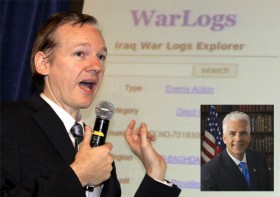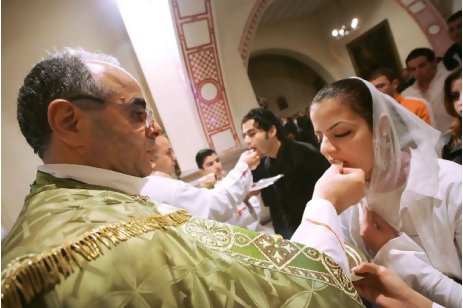
Four years ago this month, my mentor, the Canadian journalist Larry Henderson (Sept. 4, 1917-Nov. 27, 2006), one of 20th century Canada’s most distinguished citizens, died. He was a genuine renaissance man, equally at home in French or English, at a typewriter keyboard or a harpsicord, a peripatetic who spent perhaps half of his entire adult life traveling through the Middle East and Europe. Two of his closest friends abroad were the English journalist Malcolm Muggeridge and the French philosopher Jacques Maritain.
He was born in Montreal on the city’s famed Westmount Ave., near the top of Mount Royal, studied music and theater at McGill University, went to London in the late 1930s to try at acting, where he was an understudy to Laurence Olivier and Alec Guinness, returned to Canada when the war broke out, served in the Princess Patricia Brigade in the Signal Corps, fought in Italy, hiding one night in Dante’s tomb in Ravenna as the Nazis searched for him, and returned to Montreal, where, by a fluke, was hired by CBC Radio as a news reader. For the next 30-plus years, he was Canada’s most famous radio and television broadcaster, “Canada’s Walter Cronkite,” and across Canada, it wasn’t bedtime until “Larry said ‘good night.’”
The Montreal Larry was born into was nearly 90 percent French Catholic; the English Protestants had little to do with them. Larry’s father, a successful wool merchant, died of a heart attack when the Great Depression struck and his business failed; his mother was a very successful batik artist whose wall coverings graced hotel lobbies across Canada. His teenage years were spent in the company of his mother’s friends, actors and actresses and artists, including most of those who would become known as “the Group of Seven,” especially A.Y. Jackson, who would remain a life-long friend.
Back in Montreal after serving in North Africa and Italy he was hired in 1945 by CBC Radio, in Montreal, to be a news reader in Toronto, which would be his home for the next 42 years. In 1949, Larry married Joan Annand, a musician who had studied at the Royal Conservatory in Toronto, then working as a sound engineer for the CBC. She was the daughter of James Annand, once George Bernard Shaw’s stage manager, who later founded Toronto’s Shakespeare Society.
In early 1951, Larry was commissioned by the Harry Foster Advertising Agency in Toronto to produce live daily news from the world’s trouble spots for a network of 22 independent radio stations. With Joan as his technician, the pair set off for Korea.
With his tape-recorder, miniaturized – by Joan – down to the size of a small breadbox, Larry recorded the artillery exchanges and the shots of the rifles, and interviewed the men in their slit trenches, offering a running commentary, providing for the first time in broadcasting history live combat reports.
The next stop on the Asian tour was Indo-China, where the French were fighting to keep the Emperor Bao Dai in power, as Ho Chi Minh, originally selected by the Office of Strategic Services (predecessor of the CIA) to rule Vietnam after the Japanese left, led an insurgency. Ten years later, Larry would be back in Vietnam as the United States continued to try to defeat Ho.
In October 1953, Larry and Joan returned to Toronto, where he was hired by CBC-TV’s Mavor Moore and Stuart Griffiths as the first anchorman for a national TV news broadcast. In his first years, Larry interviewed scores of personalities, including a bare-foot David Ben Gurion in a tent in Sinai, who showed Larry a map of Israel, that included Lebanon and the West Bank. He interviewed Pope Pius XII in Vatican City, who was anxious to hear Larry’s views on Korea and Vietnam. One time in Jerusalem, he was summoned from his hotel by King Hussein of Jordan, who at 18, had just survived his first assassination attempt and wanted the news spread around the world. Kings and princes, businessmen and artists, musicians and writers, all sat before Larry’s camera.
By 1958, as Christine McCall wrote in Maclean’s Magazine, Larry was “TV’s Most Famous Face.” She observed that Larry’s name had become synonymous with television news, and that “he’s probably seen by more Canadians, more often, than any other television personality in the country.”
When the Suez Crisis erupted in the summer of 1956, the CBC news department was relying on film shot by American news crews in the Middle East, dubbing in dramatic music and commentary for the broadcasts. Larry proposed that he and cameraman Bob Crone travel to Egypt immediately to cover the war. Again, Larry would provide the CBC with another “first” in CBC television history: foreign coverage with sound film.
In 1957, 1958 and 1959, Larry made trips into the Soviet Union, accompanied by CBC cameraman Bob Crone. Again, he was setting precedents in Canadian journalism, penetrating the Iron Curtain with sound film. He conducted sidewalk interviews, visited schools, slums, museums, theaters, farms and factories and even took a cruise on the Black Sea, in order to see a cross-section of Soviet life as it was really lived.
The Soviet Embassy in Ottawa lodged a formal complaint against Larry. The Ministry for Cultural Affairs in Moscow, Canadian section, accused him of spying, and harshly told him his filmed reports would never be allowed out of the Soviet Union; but he persuaded some tourists in his party to smuggle them out for him. Every roll eventually made its way to the CBC, though some were delivered to The Toronto Star, which ran the headline, “Henderson Film Smuggled Out Of Russia In Woman’s Brassiere.”
Upon his return to Canada, Larry went to a massive screening of all his film, attended by TV News Director Larry Duffy. Duffy walked out without a word. “The Journey to Samarkand” was never shown on television, though he later turned it into a best-selling book. Here was a milestone in Larry’s career, for up to this time all his previous film from abroad was shown on the network, some of it as much as nine times. Even his previous Russian work from 1956 and 1957 had been aired, and he was interviewed about it on many TV special programs. This 1959 film was also shot in color, and the networks had just gone to color, so it could have been the biggest scoop the TV network had ever had.
Since Larry owned the film, he had his agent book a cross-country tour, where it showed before huge audiences. He was in Winnipeg when he read in the local paper that he had been fired from the CBC. He returned to Toronto and made the rounds at the CBC office on Jarvis Street, where no one would see him. There was no farewell, no letter of thanks, no goodbye presentation. The shabby treatment struck him at the time as a clear sign of bad conscience at the CBC. Somewhere, someone had given the thumbs down on his Russian film, and his career. Larry had no idea where it came from – from Toronto, from Ottawa or even Moscow, from the news bureau or from Lester Pearson’s External Affairs.
After a trip across Asia, he found part time work at a Montreal television station, CFCF, where he hosted a weekend program on international affairs, and on CHFI radio in Toronto.
Montreal in 1961 was an eerie experience for Larry, as his hometown woke up to the (not so) Quiet Revolution. Separatist groups, inspired by the Cuban and Algerian revolutions, such as the Rassemblement pour l’independance nationale, led by journalist and former Canadian armed forces artillery officer Pierre Bourgault, proliferated.
By March 1963, the Front de Liberation Quebec, was in full swing, bombing three military installations on March 4; then, on April 1, bombing a government tax office, CNR Central Station in Montreal and the railroads tracks at Lemieux, just before the train carrying Prime Minister John Diefenbacker on a campaign tour through Quebec arrived.
A year later, the FLQ’s terrorist campaign struck close to home for Larry, when an FLQ bomb exploded in the mailbox of the home that belonged to three generations of Hendersons on Westmount Avenue, blowing off the arms of Sgt.-Maj. Walter Leja.
The scales finally fell from Larry’s eyes when, at a meeting of the Canada-Soviet Friendship Society, in His Majesty’s Theatre in Montreal, he saw his godfather Gui Couture take over the chair, and publicly call for a Soviet Quebec. As one of Montreal’s most prominent lawyers, and a long-time family friend who lived around the corner from the Hendersons in the heart of English Westmount, Couture’s revolutionary sentiments stunned Larry.
The political and social tumult of the times ultimately led into Larry into the Catholic Church, in whose service he would spend the last third of his journalistic life. In December 1973, he was asked by Toronto’s Archbishop Philip Pocock to save the failing Catholic Register, and was plunged into the third revolution of his career: the one raging in the Catholic Church.
In May of 1986, Larry left the Register to become editor of a small monthly Catholic magazine, Challenge, which had a circulation of about 600 in western Canada. Within a few years, he built the circulation to almost 10,000, on a policy of explaining the nature of the revolution within the Church, and assurances that the revolution in Catholicism will fade away.
“Some people are talking of a new dark age,” Larry wrote in 1989. “Might it not be the beginning of a bright one?”
Such was the great man’s optimism.
Rest in peace Larry, and pray for us!
# # # #
Read Full Post »













